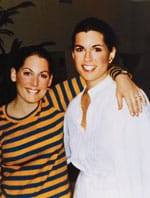Our Mission and History
Vision
A world without breast cancer.
Mission
Save lives by meeting the most critical needs in our communities and investing in breakthrough research to prevent and cure breast cancer.
A Timeline Of Key Events
Early 1950’s – The NY Times refuses to publish an ad for a breast cancer support group stating that it would not print the words “breast” or “cancer.”
1969 – The modern mammogram is invented.
1970’s – The standard treatment for breast cancer is a one-step surgical process in which a patient is put under anesthesia for a biopsy and, upon a positive result, is immediately subjected to a radical mastectomy without consultation.
1972 – Shirley Temple Black becomes the first in a series of well-known figures to publicly announce a breast cancer diagnosis.
1974 – First Lady Betty Ford openly discusses her diagnosis and mastectomy. Two weeks later, Second Lady Margaretta Rockefeller undergoes a double mastectomy.
1975 – Breast cancer patient Rose Kushner challenges the standard one-step process, opts for a less-invasive modified mastectomy and publishes the details of her experience in Breast Cancer: A Personal History and Investigative Report.
1980 – After a 3-year battle with breast cancer, Susan G. Komen dies at the age of 36.
1982 – Nancy Brinker establishes the Susan G. Komen Breast Cancer Foundation.
1982 – Komen awards its first research grant for $28,000 to Dr. Gary Spitzer at the University of Texas MD Anderson Cancer Center
1983 – The first Race for the Cure® takes place in Dallas, TX with 800 participants.
1984 – Komen founder Nancy Brinker is diagnosed with breast cancer.
1986 – The first Breast Cancer Awareness Month is held in October.
1991 – Komen establishes the pink ribbon as a national symbol for the cause by distributing one to every participant in the NYC Race for the Cure®.
1992 – Komen awards the first Brinker Awards for Scientific Distinction to Dr. Bernard Fisher, and Dr. V. Craig Jordan
1993 – Fashion model Matushka exposes her mastectomy scar on the cover of New York Times Magazine.
1995 – Race for the Cure® events take place in 57 U.S. cities
1996 – The first breast cancer awareness stamp is issue by the U.S. Postal Service.
1998 – The first international Race for the Cure® is held in Costa Rica.
2002 – More than 1.3 million participate in over 100 Race for the Cure events in the U.S. and two other countries.
2007 – Komen awards the first grant for the Komen Tissue bank, the only biorepository of its kind collecting normal breast tissue to study the causes and prevention of breast cancer.
2008 – The Race for the Cure® celebrates its 25th anniversary.
2014 – 150 Komen race events will be held worldwide, including in the U.S., The Bahamas, Belgium, Georgia, Germany, Greece, Italy, Puerto Rico and Tanzania.

 Growing up, Suzy and I were just about as close as two sisters can get. Suzy was the perfect older sister.
Growing up, Suzy and I were just about as close as two sisters can get. Suzy was the perfect older sister.
